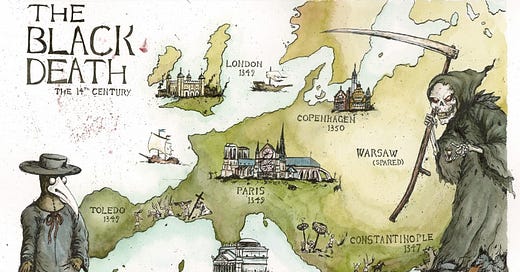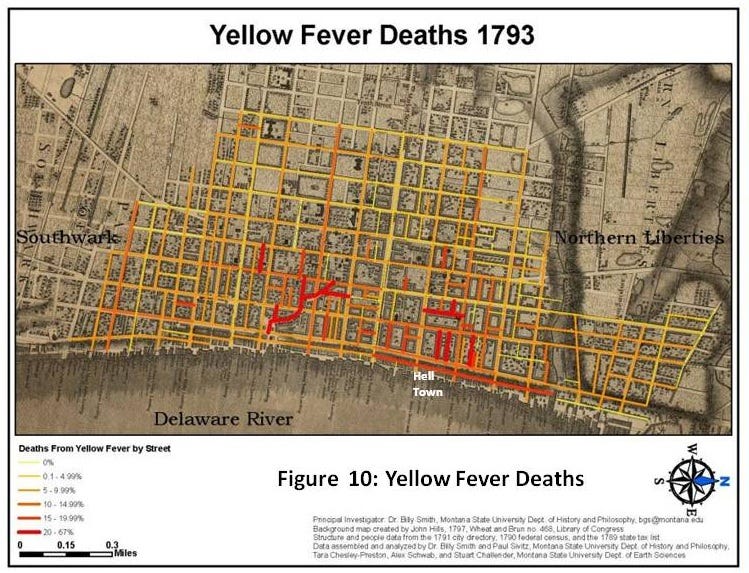As mankind evolved and established large groups of people living in close contact, early societies became aware of the phenomenon of mass illness spreading through the population. Yet it took centuries to discover the concept of communicable disease, and that was only after recognizing that if one stayed away from sick people, you wouldn’t get sick. Something so blatantly obvious to the modern world remained unknown to medicine until the 15th century, and it wasn’t until the 19th century that major breakthroughs at combating the spread of disease were being made. Even before then, however, people began to stay away from sick people … because, after all, who wants to hang out with a bunch of sick people?
It wasn’t until 1374 that Italy became the first to pass legal restrictions on the sick. In response to the Black Death, those afflicted were required to be taken “into the fields, there to die or recover.” Venice then required ships to anchor offshore for 40 days before anyone could disembark. Those of you who speak Italian understand that the Italian word for 40 is “Quaranta,” and the practice of separating the sick from the well became forevermore known as “Quarantine.”
Fast forward four centuries to the year 1700. A year earlier, over 200 Philadelphians in the British colony of Pennsylvania had died from an outbreak of Yellow Fever, prompting the provincial legislature to pass America’s first quarantine law. The law prevented the disembarking of passengers or goods off of “unhealthy or sickly vessels coming from any unhealthy or sickly place whatsoever.” However, the law was not effectively enforced for 20 years, at which time the Pennsylvania governor appointed a doctor to board each arriving vessel and prevent them from disembarking if he saw any signs of disease or illness. Eight years later, two ships from England arrived with signs of a “malignant fever,” and were prevented from landing. This was the first instance in American history of the quarantine of a diseased ship.
Because keeping diseased people onboard their ships was problematic, 15th century Italy created the “lazaretto” … an isolated residence onshore. In the 17th century, these became alternately known as “Pest Houses,” not to be derogatory of the residents, but from the Latin pestis, meaning “deadly contagious disease, a curse, bane.” A Pest House was simply a hospital for those suffering from infectious diseases. After Philadelphia experienced the arrival of two more diseased ships in 1738, discussions began concerning whether or not Philadelphia should have its very own Pest House, though it would be the first and only one in America. It was a controversial issue, so Philadelphians debated it for the next four years.
In 1741, the pro-Pest House side was strengthened by another outbreak of Yellow Fever, and about a year later … today, February 3rd, 1742 … Philadelphia spent 1700 pounds to purchase a 342-acre island at the mouth of the Schuylkill River in order to construct a hospital for infected people arriving by sea to be housed. To fund the facility, an act was passed requiring “that the nursing, medicine, maintenance and other necessaries should be defrayed by the importer, who was to give bonds for the faithful performance of his obligations, and in the event of a failure, he was to be committed to prison without bail … until he conformed.” Additionally, penalties were imposed for harboring sick persons who had been ordered to the Pest House.
The original Pest House stood until the 1790’s, when another series of Yellow Fever outbreaks overwhelmed the facility, and a new Pest House … this time named the Lazaretto … was constructed 6 miles west of the original site. The island that was home to the original Pest House is now the home of the Philadelphia International Airport, and the Pest House replacement, the Lazaretto, still stands today and can be visited … though it hasn’t served as a Pest House since 1895. The site was purchased by the Philadelphia Athletic Club and served as a summer recreation retreat for Philadelphia’s elite. In 1915 it became a flight school, seaplane base and marina, and was later used by the army to train pilots for World War I. In later years the site fell into disrepair until 2005, when it was purchased by Tinicum Township in order to prevent developers from demolishing the site in favor of additional parking facilities for the airport.
Restoration of the Lazaretto was completed in 2020, and Tinicum Township moved its municipal offices into the restored building. Ironically, two weeks after occupying the restored building, the facility that served as the second location of America’s first quarantine facility was forced to close due to quarantine measures in response to Covid 19. While Philadelphia did not operate any Pest House in response to Covid-19, it did provide limited assistance to housing in an “Isolation and Quarantine” private hotel for persons who were unable to self-quarantine. This program ended in 2022.
The Lazaretto has since reopened, and today … in addition to housing Tinicum’s municipal offices … is open to the public as an historic preservation site. Visitors may take a 40-minute self-guided audio tour or experience an interactive audio “quarantine play.”
The Philadelphia Lazaretto is not the only surviving site in the world, but as far as 5-minute History been able to determine, all have been repurposed as museums or for other purposes. However, about 20 ports of entry or border crossings in the United States have some form of temporary quarantine facility to house people with contagious disease, and large numbers of Chinese citizens were forced into massive Chinese “Quarantine Camps” in response to Covid-19. It is unclear to what extent these camps are still operating in China.
NEXT WEEK: Ike’s Warnings







These are so interesting. I can even stay awake the whole time… something I could NEVER accomplish in my high school history class!
I really like this one Jerry. In clearing out my emails, ( I only had about 8,000!) I found it, I'd saved it when I first got it. But the history is very interesting. I learned the root of the word quarantine, and about Lazaretto's, plus more history about illnesses. It reminds me of the "Poor" houses in England and elsewhere also. Thx.